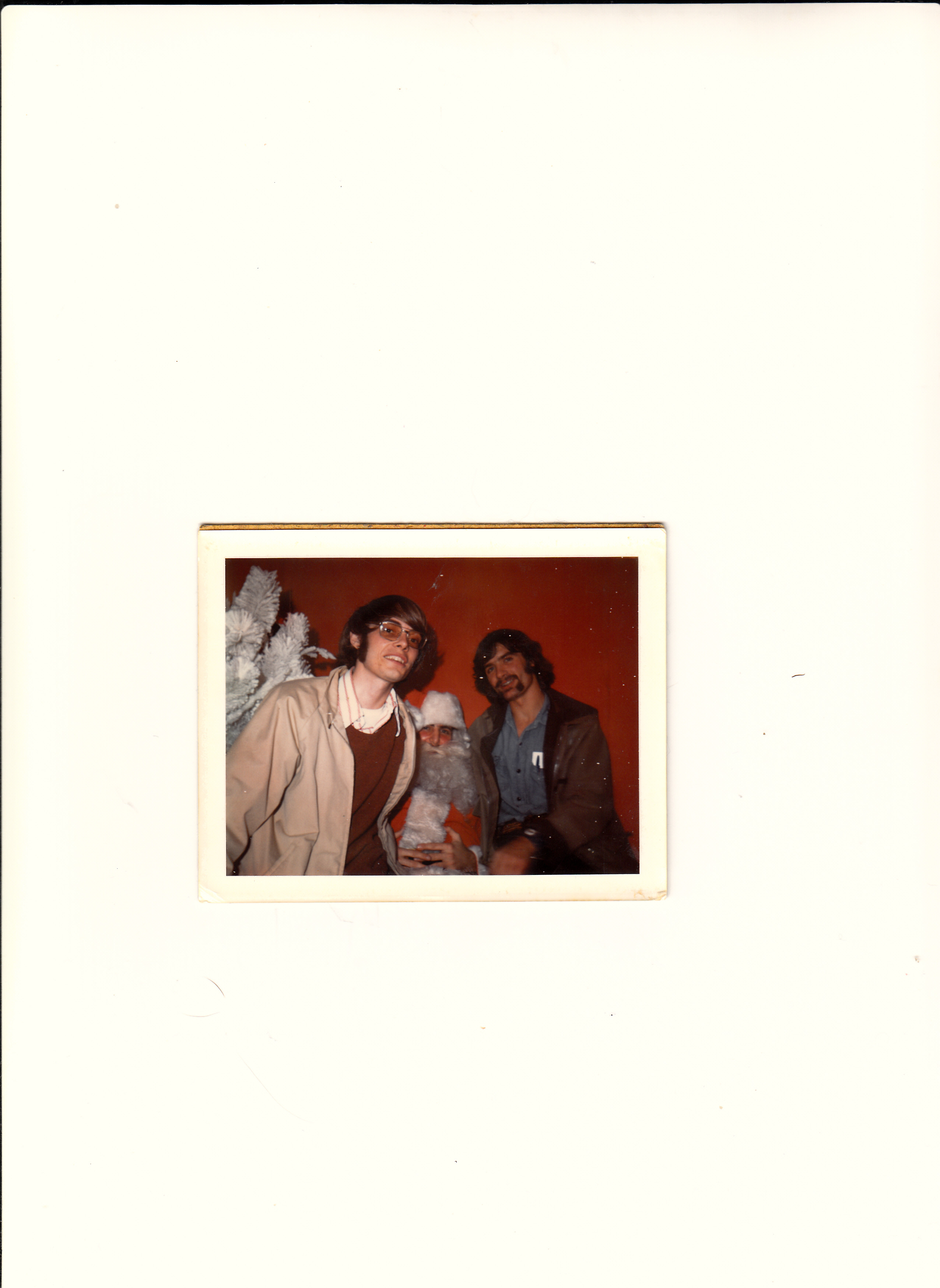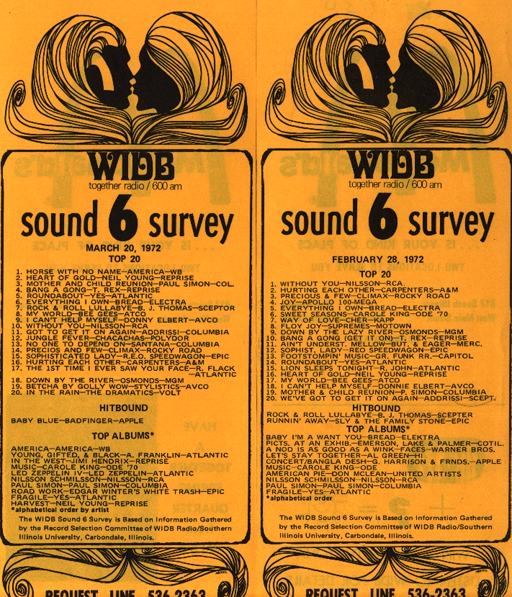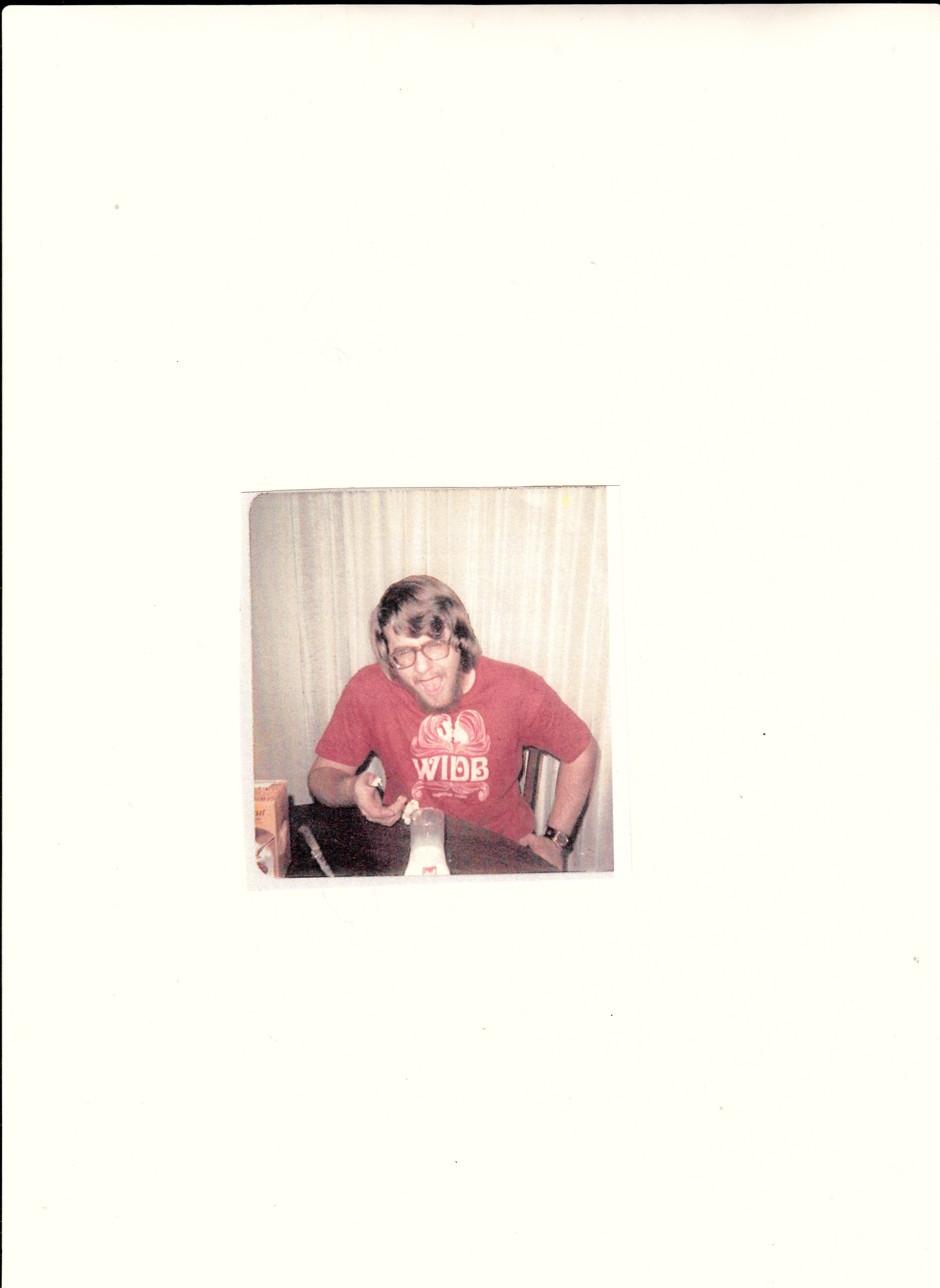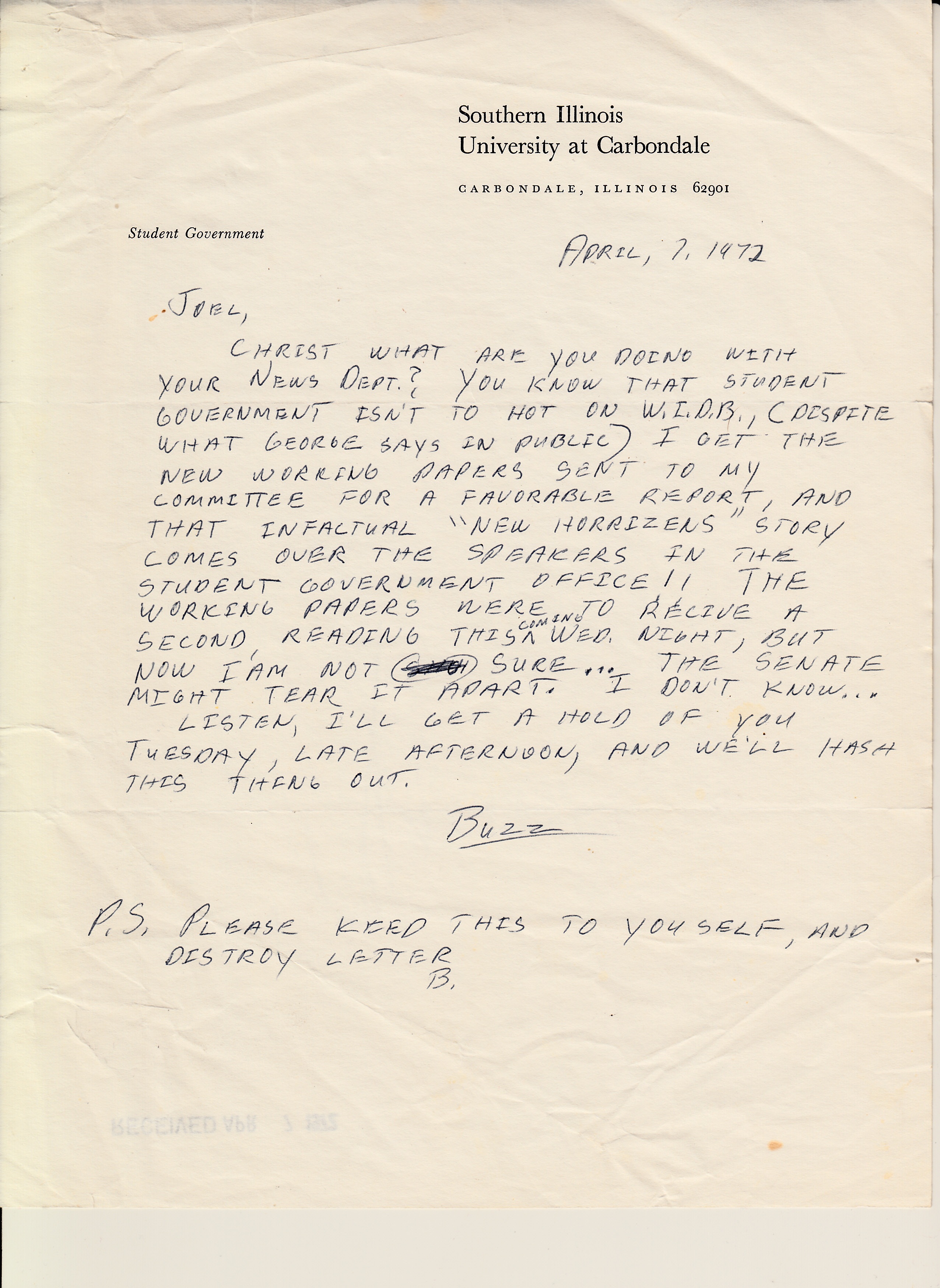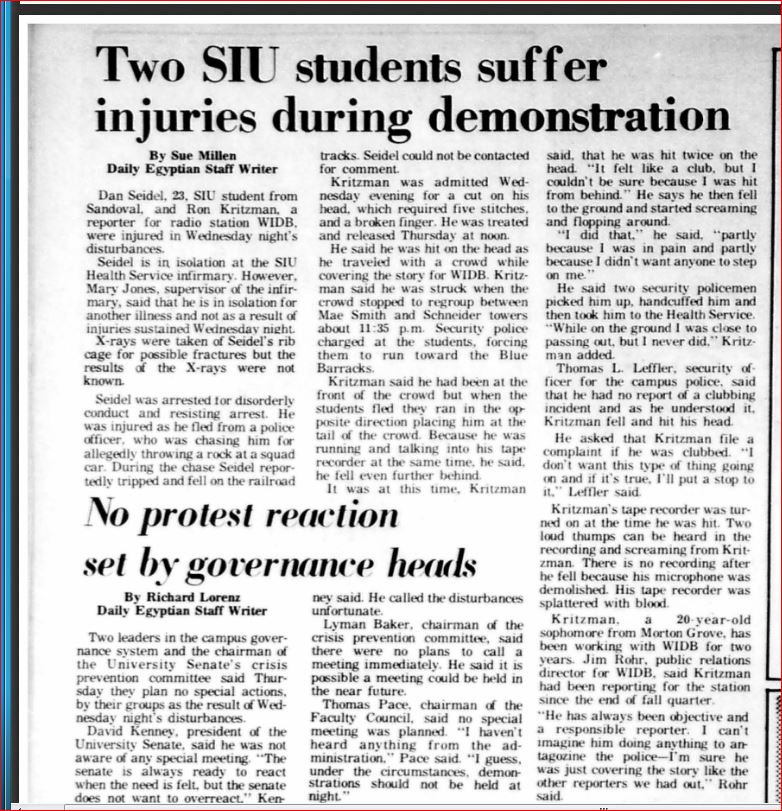CHAPTER 15
JOEL’S FIRST 11 WEEKS AS GM BRING BREATHTAKING WIDB ADVANCES
But winter Quarter 1972 still began January 2 at WIDB with some significant schedule and staff changes. In the fall. mornings had been done by Robbie and Woody Mosgers (Woody’s World). Woody was talkative, irreverent, and foreshadowed a “morning zoo” format. Woody left a few weeks before the end of the year and his shift was taken by Joel himself. Joel billed himself as the “Virgin Jock,” and one memorable highlight of his show was perusing the Sun-Times, noting “Bargain-Town” ads. No recordings have ever surfaced of any Virgin Jock shows.
During the 11 weeks of Winter Quarter, WIDB made breathtaking strides. These were also Joel’s initial 11 weeks as GM. WIDB expanded to 24-hour operation. Coverage expanded to the Student Center, Carbondale Cable channel 13, and Cable FM 104.1. There was a new Music Director, new on-air talent, and it seemed that more and more students knew about and/or listened to WIDB.
Joel knew his future did not lie in jocking, so in January, Mike Murphy started mornings. “Murph” came from WLTL, Lyons, was a Bleacher Bum Cubs fan, and loved Wally Phillips (who did mornings on WGN). Since Wally was getting 50+ share in Chicago, Murf followed Wally’s ideas of using drop ins and taking phone calls. Ed Kasovic became his engineer and essentially Murph’s producer. Morning audiences soared for WIDB in 1972. Here is a “slice of life” from one of Murf’s first morning shows on WIDB.
Meanwhile, WIDB’s Wally, Wally Wawro, left as Music Director. Wally had always been more of a jazz guy and WIDB was still mainly top-40. Wally may well have been ahead of his time. In 1975, for example, when WIDB played a lot more jazz, Wally would have been a much better fit. But in 1972 Tom wanted WIDB to emulate WLS and WCFL’s top-40 sound, which was not Wally’s favorite. Wally went on to work at TM Productions in Dallas for many years.
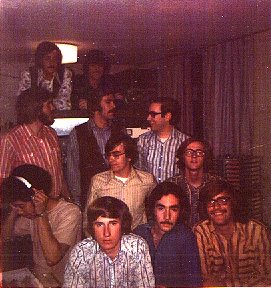
WIDB top-40 jocks, Winter 1972 FRONT LEFT:Dennis Lyle, Jim Walsh, Mike Murphy MIDDLE ROW LEFT: Ed Clanton (Bro. EC), PD Tom Scheithe, Robbie Davis, BACK LEFT: Kevin J. Potts, Keith Weinman, Roger (Ramjet) Davis TOP LEFT Marty (Justin Case) Bass, Operations Director Sam Glick NOT SHOWN: Todd Cave, Music Director
But in January 1972 Tom appointed a new Music Director who was an extremely enthusiastic 18 year old freshman who loved the Turtles and the Jackson Five and wore his Captain America shirt at the station. He ended up having the greatest influence on WIDB’s music and programming over the next five years, greater than any other person. His name was Todd Cave.
Even though these were the last few months of WIDB’s top-40 programming, most members were solidly behind it and embraced top-40 skills and priorities. “Tightness” and “flow” were important in programming, which required matching the right jingle with songs, for example. When it came to music, there was a 40 song playlist. Except for 3 “oldies” per hour, all music came from the playlist, from 7am-10pm every day. The 40 songs were selected each week by the music director. So almost 90% of WIDB music was selected by one person.
In January, 1972, that person was a barely 18 year old freshman. He liked Chicago, the Turtles, Beach Boys, Jackson 5, even Donny Osmond. But he also liked Aretha Franklin, Temptations, Todd Rundgren, Yes, Paul Simon, Neil Young, T Rex, Bill Withers, Billy Preston, and Grand Funk. Here is how Todd sounded on WIDB in his first few weeks.
At that time the shared aspiration was to sound like the great top-40 stations, WLS, WCFL, WABC, CKLW, KHJ, etc. There was a constant flow of airchecks from these stations; many wanted to listen and learn what was new at these stations.
We learned that there were constant innovations in Top-40 music, programming, jingles, production styles, etc. We wanted to keep up so we would be ready to work at the highest level. So when it came to programming music, it was more about “being like the big stations” rather than selecting music suitable for the audience. The “big stations” tried to program records that would become big hits, and the earlier they played them (and the more success the records would have) would be a mark of success and pride for the Music Director. The MD was supposed to use his own judgment and not wait for the record to prove itself at other stations before deciding to play it.
Before he left WIDB, Wally Wawro selected music he liked for the playlist, such as “Tightrope Ride,” by The Doors and “Behind Blue Eyes,” by Who. But many of the ones he selected were not hits (“Went nowhere,” we would say) and Wally was shown the door.
With that backdrop, Todd knew he would have a short leash and better not screw up. One of the toughest challenges for Music Directors in Todd’s position was to select an artist that had no prior hit or track record. It was usually safer to play artists with established names. But Wally had played the Who and Doors and it didn’t work.
In his first quarter as Music Director Todd demonstrated an uncanny knack for picking first hit artists. He played “Roundabout” by Yes, “Horse With No Name” by America, “Heart of Gold” by Neil Young. Todd would play these months and weeks before other stations. The result was WIDB always sounded brighter than WLS, etc, because WLS was playing WIDB’s songs from months ago, and sounded old and dead. In the spring he played Roberta Flack (“First Time Ever I Saw Your Face”) Bill Withers (“Lean on Me”) Todd Rundgren (“I Saw the Light”) Jackson Browne (“Doctor My Eyes”). Everyone played these songs eventually, but Todd and WIDB were weeks and months ahead.
The first WIDB shirts were printed and distributed in March. It was a navy kissing twins logo on a yellow shirt. These shirts were the only WIDB thing we had, and the shirts were worn to death. Your author’s shirt was only off for washing. Only one of them survived 1972.
Of the second shirt generation we have the navy on green (not pictured) and the white on red.
WIDB also was cementing its its role in the lifestyles of students. On February 2, 1972 (Wednesday) your author arrived at the station about 11 am to find a complete hotbed of activity. All phones were manned, all lines lit, and the calls kept coming in over and over. “What happened?” I wondered. A riot? A disaster? No one could answer me because the calls kept coming in. Finally I figured out that the draft lottery for those born in 1953 had just come over the UPI wire. (This did not apply to your author, thus off his radar).
Why was this of such crucial importance to so many? The war was still going on, and they were still drafting. If you were drafted, you could be in Vietnam in 30 days, and we saw (and heard from) the vet students who survived and then came to SIU. Almost all of them looked like (and told you) they were scarred for life, inside and out. There were many many other reasons people thought the draft was wrong but almost everyone thought being drafted was “not good.”
Prior to 1970 or so, there was a system of deferments that allowed, for example, a full time student at SIU who kept a “C” average to be exempt. This swelled the ranks at easy-admission low-tuition SIU. But starting in 1969, there was a draft lottery every so often for separate birth years.
This is how it worked. On February 2, 1972, they picked the numbers for birth year 1953. this meant that if you were born in 1953, and your birthday was picked first, you were going to Vietnam FOR SURE and probably RIGHT AWAY. It did not matter if you had paid tuition, a housing contract, a girlfriend, etc. However, if you were picked after 100 or so, you were probably safe. They had to take all the people on the first birthday, then move to the second one, etc, until the quota was reached.
So on February 2, 1972, these numbers were drawn at 11am EST in Washington, DC and would appear in the newspaper the next day. Few wanted to wait. They did not call WSIU, WCIL, University News Service, the Daily Egyptian, or the Southern Illinoisian. They called WIDB. What was their boyfriend’s number, their own number, their friend, roommate’s number. It went on all day long, and into the evening.
Your author ran into a fellow student that evening who was on his way to Canada because he had been picked #1. Just halfway thru the quarter, he was never seen on campus again.
This was very important, perhaps THE most important thing that day to students, and where did they turn? WIDB. Only 5 weeks later students also turned to WIDB for immediate information when the crane collapsed on a crowd of students. WIDB was established as the “go-to” place for info important to students.
WIDB extended itself in yet another way. Joel finally secured the “across the hall” temporary space for WIDB. It was designed as living quarters for up to 8 men, with closets and its own bathroom and shower. There was a front (smaller) room where the bathroom was, and there was a wall dorm phone. The back room was much larger with curtains, closets, and windows overlooking the wooded area between Boomer & Wright. There was room for 6 desks and a couch! Staff meetings did not have to be in the laundry room any more.
At this point WIDB had signed on less than two years ago. Not on during summers, breaks, or when SIU closed, WIDB had only programmed about 15 months. Yet WIDB was substantially integrated into student life. It was heard behind many doors in dorms. It was sought out for information. People knew about WIDB.
This confirmed almost everything the proponents of SIU student broadcasting had expressed since 1959. There were important student needs not being served that could and should be served by students. Remember SIU’s broadcasting expert, Buren C. Robbins’ claim that “WSIU would serve students’ needs.” When the crane crashed on March 6, 1972 at 10am, WIDB had news bulletins and a person on the scene in minutes, as well as numerous follow-up comprehensive reports minutes and hours later. No one at WSIU knew about the crane crash until about 4pm, when someone looked at the teletype. Several surveys done over the years never showed WSIU with more than 6% student audience, with WIDB getting 60-80% in dorms.
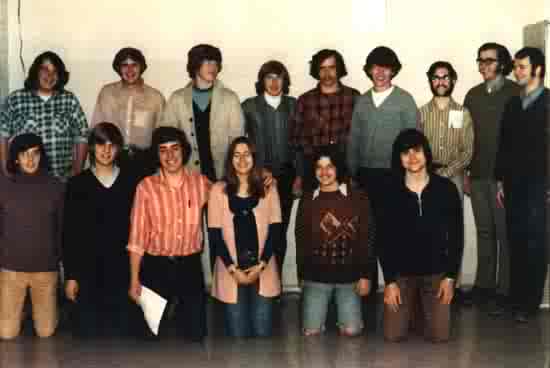
WIDB news staff, March, 1972 Front left Phil Kline, Tim Carvis, Gary West, Katy O’Neill, Pete Jaeger, Todd Cave BACK LEFT Bill Leebens, Ron Kritzman, Chris Bury, Dennis Lyle, Don Graf, John Rouse, Alan J. Friedman, Cliff Albert, News Director Frank Mazzocco. NOT PICTURED: Debbie Santarelli, Roger Davis, Steve Klinkert, Mark Henkes
Remember Robbins’ idea for the university to pay for FM radios in every dorm room tuned only to WSIU? If that had been done instead of WIDB, no one would have known for hours that students had been severely injured and killed, and power was off on much of the campus.
It appears this very success, students developing employable skills and careers, was what the administration sought to extinguish.
Meanwhile, WIDB expanded its programming reach. By February, Joel was able to somehow cajole Doc Daugherty into allowing WIDB to be carried over the Student Center speakers. (Previously WCIL “Muzak” ie. “elevator music” had been used). The station was not only in hallways but piped into student activities, student government, etc. Also, where the bookstore is now used to be a lounge for students (“Magnolia Lounge”) with couches and fireplaces. WIDB was piped in there, at higher volume than the hallways.
This was good and bad. When the construction crane collapsed on a crowd of students near the Student Center at 10 am on Monday, March 6, 1972, students crowded into the Magnolia Lounge to hear the WIDB news reports about the students who were killed. That was good. (Not the students being killed, but the reliance on WIDB). But in April, when Joel wanted the WIDB working paper revisions approved by the Student Senate, WIDB news featured New Horizons Party candidates, political opponents of Joel’s allies, who were listening in the student government offices. Even worse, the opponents dissed Joel’s allies and the newsperson did not seek a response. This was bad, leading to the attached letter from Joel’s guy, Sen. Buzz Talbot. The Working papers revisions were passed, but Joel had to do some “leaning” which led to fallout.
During April, there were Student Government Elections. Joel had to use up some favors to get the Working Papers amendments thru the Senate, so Joel kind of “owed” Vice-president Jim Peters of the Student Involvement party , who was running for president against Jon Taylor of the New Horizons Party. When he had them down to the station for an “Anodyne” show, he showed some favor to Peters by having Peters in the studio with him (Joel) while John Taylor had to sit outside.
Dave Silver observed this obvious favoritism during the live show and said “Peters better win this election or Joel and WIDB will be in trouble.”
Jon Taylor won the election, which was fraught with controversy. One example is ballots found in a Wall Street ditch where they had apparently been thrown by Election Committee workers en route from a polling place to election central. Another example was months of contentious hearings challenging Taylor’s eligibility. But Taylor eventually became president and Joel, somewhat red-faced, had to make amends. It turned out easier than he could have imagined.
Remember the Dynamic LTL and the Soul show? By May, this was one of the most popular shows on WIDB, Tuesdays 10pm-2am. One of the first Tuesdays after the election, Jon Taylor shows up at WIDB at 1am during the Soul Show. Of course, we immediately put him on the air and you can hear what he had to say about WIDB here:
Your writer feels unqualified to characterize or comment on the special social fabric black students had at SIU. But your writer did observe it occasionally.
Jon Taylor was the first black student body president SIU ever had. One of the first things he did was to come to WIDB to address the audience of the Soul Show. This was very flattering to WIDB and the Dynamic LTL, especially in view of the WIDB News episode. Joel’s problem got solved by the Dynamic LTL.
Carbondale actually had cable TV by 1972, and Joel arranged for WIDB to be carried on the FM. The original frequency was 104.1, and the audio was all mono. But now the station could be heard off campus. At that time, very few people had cable, few had FM, and almost no one hooked up the cable to the FM to get WIDB. So it seemed far-fetched that being on the cable would ever do much for WIDB. To increase WIDB’s reach thru the cable, Joel got the cable system to carry WIDB on Channel 13. This may not seem much by today’s standards, but at the time it was a huge step for WIDB.
When Carbondale Cablevision started in 1972, there were only 13 VHF channels. There was no cable box. You attached the “cable” to your 13 channel rotary-tuner TV to get the local stations (Harrisburg, Paducah, Cape Girardeau, and WSIU) but also the St. Louis Stations (KMOX, KTVI, KPLR, and their PBS channel) one channel on the cable was “local” programming, and channel 13 was the weather dials.
The “weather dials” were a row of meteorological meters (temperature, humidity, barometric pressure, wind speed & direction, etc). An automated camera would zoom in on each meter and pan slowly back and forth, 24 hours a day. And WIDB was the audio.
Keep in mind that just as few had FM at that time on their radios, most TV’s were only channel 2-13. All TV’s had mono speakers. The motivation to get the cable was to access the St Louis stations, but while sitting around engaging in the usual libations, watching the weather dials and listening to WIDB became very convenient and appealing.
With these new outlets for WIDB, Joel felt it was important to program 24 hours. The station had been signing off from 2-7am weekdays and 4-10 am weekends. It did not seem feasible to fill shifts during these “late night” hours. So Joel found “Tape-a-Thon” at Trueblood. Tape-a-Thon was a reel-to-reel tape player only, played at 3.75 IPS and had two important features: it used 10.5″ reels and it reversed automatically. Thus,it would play up to 6 hours of recorded program. This may seem basic and stupid by today’s standards, but in 1972 the only automation systems were all reel tapes and cost hundreds of thousands of dollars. Joel got the Tape-a-Thon for nothing. But the programs had to be recorded.
So “All Night Music” was born. Katy Jascula, under Tom’s direction, recorded numerous liner/ID’s which were assembled on one long cart. The format was just to segue generally downbeat music and play a liner/ID every 1/4 hour. No other talking or announcing songs. The shows were recorded in 3 hour segments (one side of a 10.5″ tape). After two weeks of recording live shows, there were about 10 6-hour tapes in the can. Here is a brief excerpt of the transition into All Night Music at 2am:
It worked good, in future years this time slot would be called “Pillowtalk” and was done live. But in 1972 it allowed the station to be 24 hour for the first time.
As the weather turned warm in March, thoughts turned to Campus Beach. The lake was (relatively) clean then and it was a pleasure to swim. There was a large wooden raft about 100 yards out, that could accommodate 10-15 people. Some of us went to the beach and came back to report it was great but there was no music we could get on the radio. And that was true. In the daytime, with an AM transistor radio, you probably couldn’t even get KXOK, there was no WTAO yet. So enterprising WIDB engineers decided to address this problem. A phone line was installed to carry the audio, the spare 4-watt transmitter made its way to the beach and voila: WIDB was REALLY on the air at 600AM.
It worked great. We did get some calls from people wondering how they got it in their cars. We would just ask “Are you near any utility lines?” and they would say “Oh yes, I can see some over yonder,” and we would tell them it was leaking from the lines.
Your author would bring his transistor radio out to the beach Sunday morning in a plastic bag for the 100-yard swim to the raft, and then lay on the raft and listen to WIDB. People could use the beach house phone to call in requests. There was a WIDB sign on the beach house with the request line #. It is a great memory. Pirate mentality lived on into the ’70s.
As spring and even summer weather extended into May, national events triggered local protests. President Richard Nixon announced increased bombing of North Vietnam and mining of harbors. During the first week in May protest rallies were organized at SIU. Just as in 1970 (when students murdered at Kent State triggered a nationwide response), there was great concern at SIU about extreme responses to protests elsewhere.
The WIDB news department (with help from those who knew a few phone tricks) was able to send and receive lengthy reports of protests and extreme responses from all over the country. Here is a 9:45 WIDB extended newscast from that time with Chris Bury, Katy O’Neill and Mike Slabik. (In fact, the SIU march, planned for the next night, is mentioned in this newscast):
Here is a follow up “news bulletin” aired at 1am with Assistant News Director Chris Bury:
Here is another at 1:30 am with News Director Frank Mazzocco:
You may ask, “Why are Frank and Chris at the station at 1:30 am doing this?” The answer is that they had the highest dedication to their job, to keep students informed as professionally as possible. There was no newsperson scheduled, so Chris and Frank came in. That’s the kind of leader Frank was. That’s the kind of dedication Chris had. A fantastic example for the news staff.
The SIU protest march happened the next night. It was supposed to start at 9pm and come to the Towers. Around 9:30 pm, your author and Harvey Michaels walked over to the Schneider/Mae Smith area and looked north.
At that time there was a large vacant field from there to across Grand Avenue. A few years before, this had been a trailer court called “sin city,” and Howie Karlin had lived there. A few years later, the co-rec center was built on the north side of Grand. But in 1972, there was nothing there, and one could stand between the towers, look north, and see almost all the way to Hester street, past Grand.
That’s what Harvey and your author were doing, as we were advised that the protest march was supposed to come towards the towers, from the north.
It was a candlelit march. At first we saw a few candles in the distance, on the far side of Grand. Then there were more and more candles, spilling into the open fields. More and more kept coming from the north, all holding candles. Now there were thousands of candle holding protesters, completely filling this square-block field. we could see their faces and hear their yelling.
The field was jammed and more kept coming from the north. The crowd moved towards the towers. Harvey went back to the station because his show started at 10. Your author went into Schneider to use the lobby phone to call the station to give a news report about the protest event. While giving the report live on WIDB, your author noticed a protester pulling the fire alarm. Thinking fast, your author reported not a false alarm (because there could have been an actual fire somewhere in the building) but that “I just saw someone pull the fire alarm and I do not see any smoke or fire here,” which was true and accurate.
The purpose of pulling the alarm was to get everyone out of the dorms to join the crowd, which then moved to the strip.
Your author returned to the station as the 9:45 newscast finished and Harvey was starting his show. “It’s 10 O’clock Carbondale…and there’s a riot going on!” Then he played “There’s a Riot Going On” by Sly & Family Stone, then “Volunteers” by Jefferson Airplane and then “Street Fighting Man” by the Rolling Stones. “Everybody into the streets! The Revolution is here,” announced Harvey.
Just hanging out and taking all of this in, your author asked:
YA: Gosh Harv, do you really think this is a good idea?
Harv: What do you mean? It’s the revolution!!
YA: Oh, I didn’t know….I guess it’s OK then.
Meanwhile, at Schneider, a cadre of over two dozen SIU, Carbondale and State police with weapons drawn, formed a blockade around the building and dared residents to come out. When they did not, police tear gassed Schneider and physically attacked any student they could find.
Kevin J. Potts was on the 14th floor of Schneider at the time. “I’ll never forget seeing the police in armor and helmets drawing their weapons, and their hate filled faces daring us to come out so they could try to kill or injure us. And we were just sitting in our room, doing nothing. The message was loud and clear. No student was welcome in Carbondale. The police and SIU authorities will put student lives in danger and want enrollment to drop to zero.”
Tim Carvis provided a recording of the police scanners at this exact moment:
Kevin was not injured but the same police viciously attacked a WIDB newsman. More details here in the posting of the victim, WIDB Newsman Ron Kritzman.
It seemed like things were very bad, getting worse and would never change. No one know that within 10 months, protests and demonstrations would be replaced by streaking.
During May, the strip was closed to cars weekend nights. WIDB Newsmen Tim Carvis and Alan Wood were on the strip interviewing an Illinois State Policeman videotaping the crowd for evidence. Al interviewed Mayor Neil Eckert too. Here are the excerpts:
It had been about a year since Charlie casually mentioned to Dean Molton that WIDB would be advertising. Now the battle lines were drawn, and the university and Derge were about to be set on their collective ear by Joel and WIDB.
But during this time, WIDB had still been a radio station, 24 hours/day, 18 newscasts/day, people coming and going, learning and developing their acumen and talents, despite SIU administrators. Sam Glick became Program Director. He changed some of the jingles. Murph and Robbie were still doing mornings, Justin Case and Brother EC were doing evenings, and WIDB was firmly established on campus. Many staffers mentioned that when they walked down the halls of their dorm (or another dorm that they were visiting). they heard WIDB on behind every other door. Surveys showed WIDB had an 80 share and a 30 rating in dorms on weekday evenings. WIDB was consistent, reliable, and the best thing students in the dorms could get on radio.

